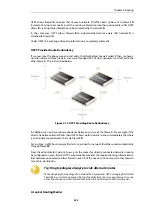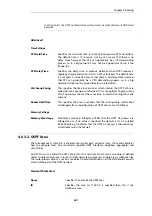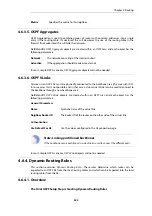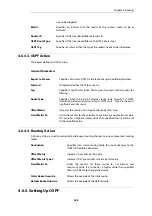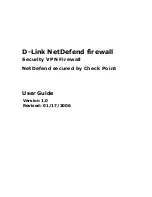
multicast address
224.0.0.5
. Those packets will be heard by all other
the OSPF routers on the network. For this reason, no configuration of
OSPF Neighbor
objects is required for the discovery of neighboring
routers.
•
Point-to-Point - Point-to-Point is used for direct links which involve
only two routers (in other words, two firewalls). A typical example of
this is a VPN tunnel which is used to transfer OSPF traffic between two
firewalls. The neighbor address of such a link is configured by defining
an
OSPF Neighbor
object.
Using VPN tunnels is discussed further in
.
•
Point-to-Multipoint - The Point-to-Multipoint interface type is a
collection of Point-to-Point networks, where there is more than one
router in a link that does not have OSI Layer 2 broadcast/multicast
capabilities.
Metric
Specifies the metric for this OSPF interface. This represents the "cost" of
sending packets over this interface. This cost is inversely proportional to
the bandwidth of the interface.
Bandwidth
If the metric is not specified, the bandwidth is specified instead. If the
bandwidth is known then this can be specified directly instead of the
metric.
Authentication
All OSPF protocol exchanges can be authenticated using a simple password or MD5
cryptographic hashes.
If Use Default for Router Process is enabled then the values configured in the router process
properties are used. If this is not enabled then the following options are available:
•
No authentication.
•
Passphrase.
•
MD5 Digest.
Advanced
Passive
Unless an interface is being used by the OSPF router process to
connect to another OSPF router, this option should be enabled. In
the Web Interface the option is called
No OSPF routers connected
to this interface
.
When enabled, no OSPF traffic will be generated on the interface.
Hello Interval
Specifies the number of seconds between
Hello
packets sent on
the interface.
Router Dead Interval
If not
Hello
packets are received from a neighbor within this
interval then that neighbor router will be considered to be out of
operation.
RXMT Interval
Specifies the number of seconds between retransmissions of
LSAs to neighbors on this interface.
Chapter 4: Routing
343
Содержание NetDefendOS
Страница 30: ...Figure 1 3 Packet Flow Schematic Part III Chapter 1 NetDefendOS Overview 30 ...
Страница 32: ...Chapter 1 NetDefendOS Overview 32 ...
Страница 144: ...Chapter 2 Management and Maintenance 144 ...
Страница 220: ... Enable DHCP passthrough Enable L2 passthrough for non IP protocols 4 Click OK Chapter 3 Fundamentals 220 ...
Страница 267: ... SourceNetwork lannet DestinationInterface any DestinationNetwork all nets 4 Click OK Chapter 3 Fundamentals 267 ...
Страница 284: ...Chapter 3 Fundamentals 284 ...
Страница 360: ...The ospf command options are fully described in the separate NetDefendOS CLI Reference Guide Chapter 4 Routing 360 ...
Страница 392: ...Chapter 4 Routing 392 ...
Страница 396: ...Web Interface 1 Go to Network Ethernet If1 2 Select Enable DHCP 3 Click OK Chapter 5 DHCP Services 396 ...
Страница 419: ... Host 2001 DB8 1 MAC 00 90 12 13 14 15 5 Click OK Chapter 5 DHCP Services 419 ...
Страница 420: ...Chapter 5 DHCP Services 420 ...
Страница 424: ...2 Now enter Name lan_Access Action Expect Interface lan Network lannet 3 Click OK Chapter 6 Security Mechanisms 424 ...
Страница 573: ...Chapter 6 Security Mechanisms 573 ...
Страница 575: ...This section describes and provides examples of configuring NAT and SAT rules Chapter 7 Address Translation 575 ...
Страница 607: ...Chapter 7 Address Translation 607 ...
Страница 666: ...Chapter 8 User Authentication 666 ...
Страница 775: ...Chapter 9 VPN 775 ...
Страница 819: ...Chapter 10 Traffic Management 819 ...
Страница 842: ...Chapter 11 High Availability 842 ...
Страница 866: ...Default Enabled Chapter 13 Advanced Settings 866 ...
Страница 879: ...Chapter 13 Advanced Settings 879 ...





